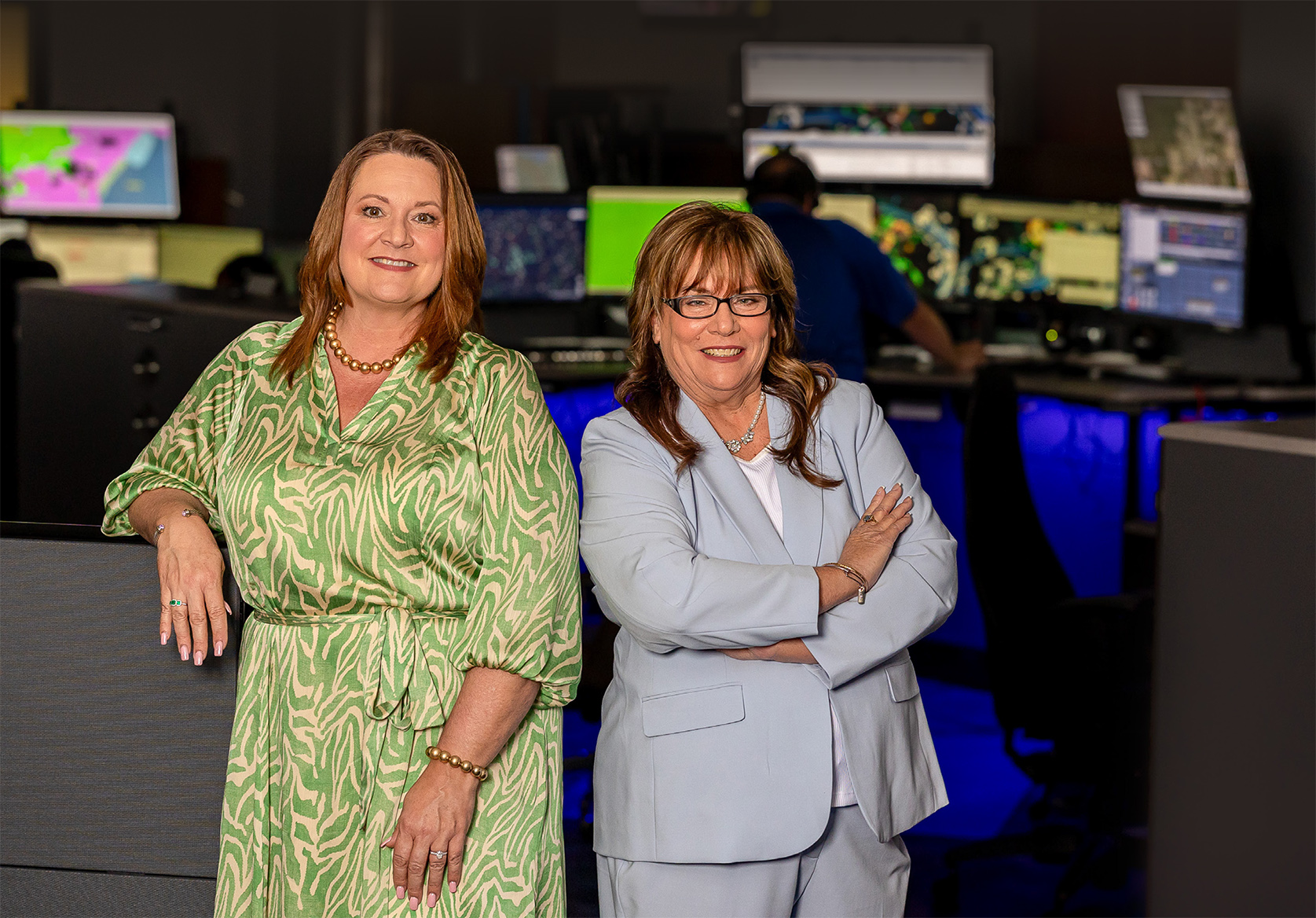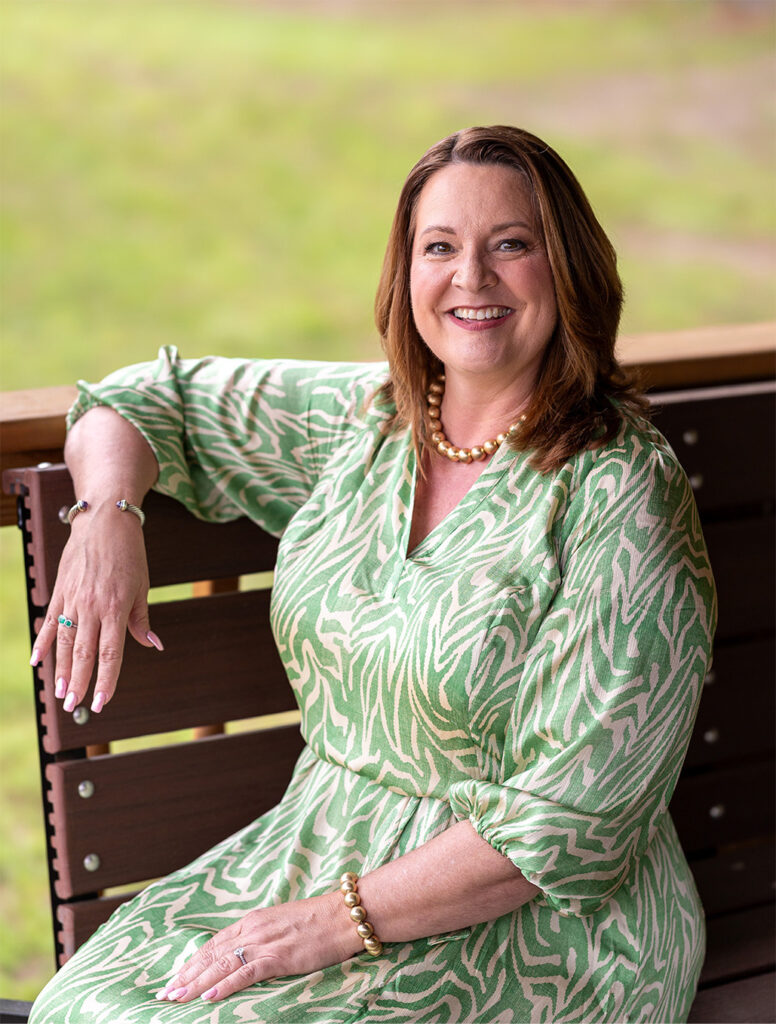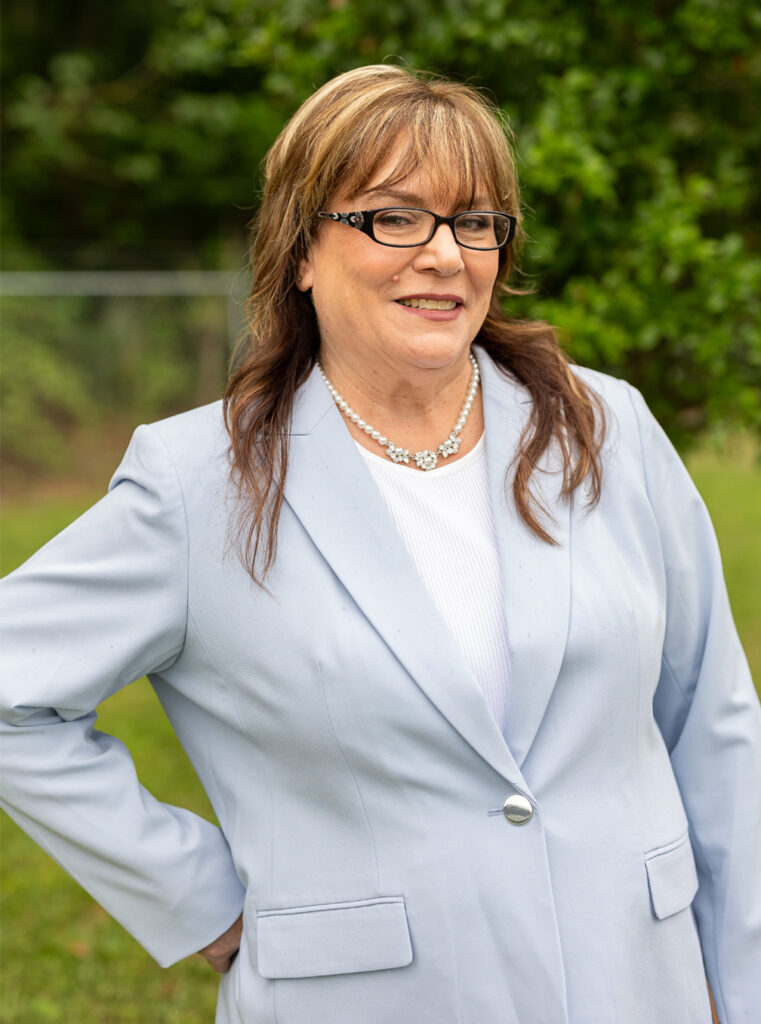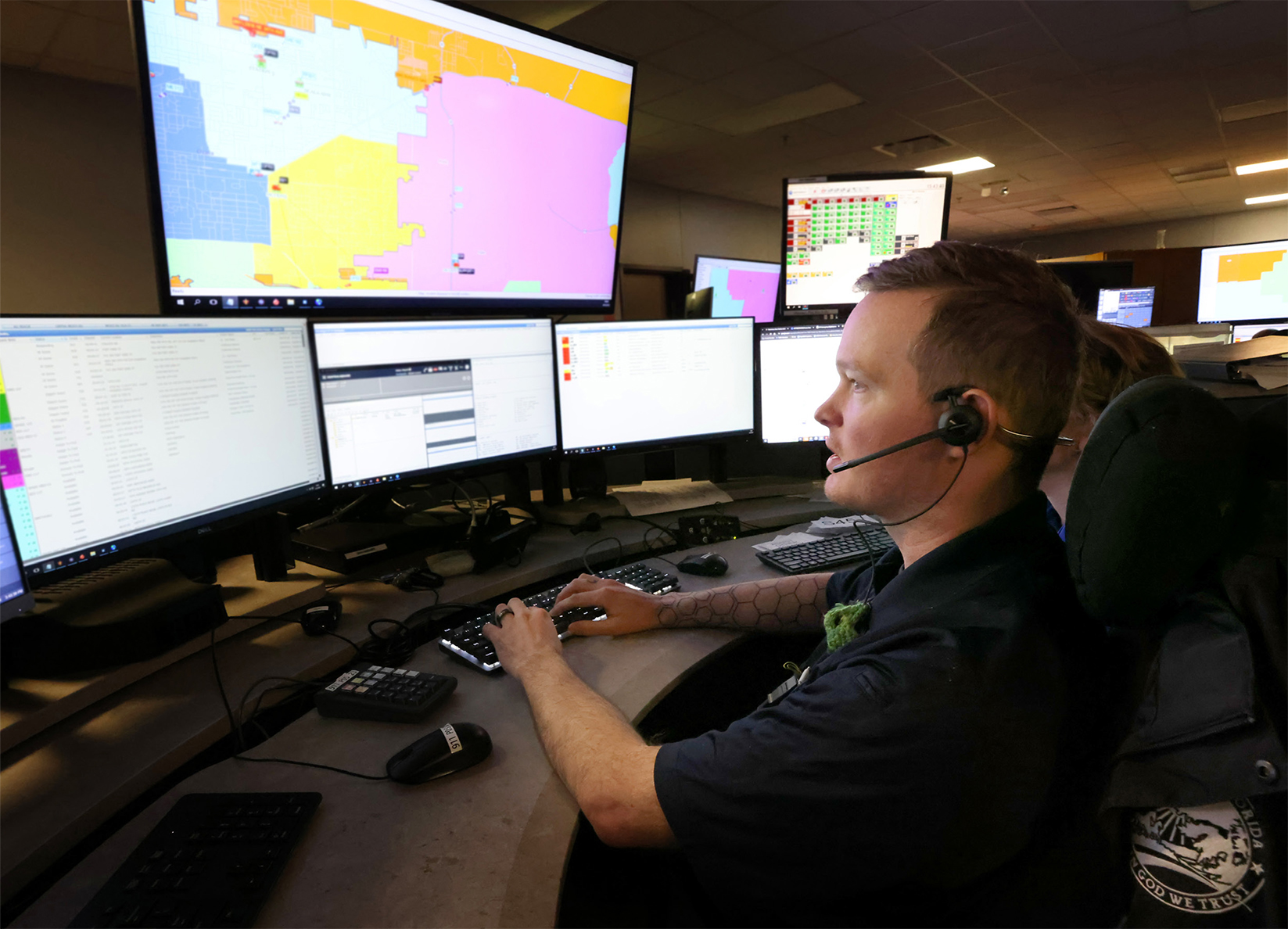Meet two women in leadership roles with Marion County’s 911 Communications Center.

Pops of color from computer monitors illuminate the darkness inside the cavernous main room in the Marion County Communications Center. Soothing voices politely but firmly make inquiries and murmur directions to callers who often are distraught and sometimes can’t remember their own address. The wail of a siren, coming through a computer terminal, occasionally pierces the low hum of voices.
This is the heartbeat of Marion County’s Public Safety Communications department. It is staffed by telecommunicators (call takers), dispatchers and administrators, and is where what are sometimes life or death calls are routed to field response units. While what happens in this room supports the organization’s success, what happens behind the scenes is equally important.
Two of the key leaders for this county department are Public Safety Communications Manager Lisa Cahill, and Michelle Hirst, Director, 911 Management. They manage budgets, people and equipment on behalf of the Marion County Board of County Commissioners. Hirst has offices on Silver Springs Boulevard. Cahill is based at the communications center on the campus of the Marion County Sheriff’s Office.
“I’m the 911 coordinator for the county, meaning I oversee the county’s 911 system,” Hirst says. “I work across town. I have a staff of eight. We handle the equipment side of the house and the addressing and road naming for the entire county, to include all the municipalities, because a physical address is the foundation of the 911 system.”
“I manage the operations center portion of our communications center,” explains Cahill. “We take all of the incoming 911 and nonemergency calls for the unincorporated areas of the county, the city of Belleview and the city of Dunnellon. We don’t handle the city of Ocala, but we handle their backup calls; they handle ours. We dispatch for fire and medical and Marion County Fire Rescue handles all of the medical calls in the county.”
Among the duties for Hirst’s team is creating geographic information systems (GIS) layers, which are critical to pinpointing locations.
“I have a GIS analyst on staff and that is her job, basically, creating all of the layers, the address point theme and the street centerline file, because the maps inside the communications centers and in the mobile display terminals on the first responder vehicles can route them directly to the caller,” Hirst says while motioning at some of the people inside the center. “Everything my staff does is map-centric and supports everything happening here and at the Ocala Police Department’s primary communication center. Even though people don’t think about an address—they think about their mail, or the pizza delivery guy—they don’t take into account what first responders need.”
Hirst says the board of county commissioners “is the responsible fiscal agent for the fund that helps to fund the 911 Communications Center.”
“I am solely funded off of 911 fees, so every telephone or device you have that can access the 911 system gets charged a 40 cents per month fee that comes to me to help provide 911 service in Marion County,” she outlines. “Lisa has the bigger job of managing all the people who answer the calls and dispatch the units for Public Safety Communications. We are in constant communication, and we come together every other month for an operations committee meeting that includes the Ocala Police Department, the Marion County Sheriff’s Office, dispatch and Public Safety Communications.”
Both women have several years of experience in their roles.
“I started with the Marion County Sheriff’s Office in November of 1995 and remained until we consolidated with Marion County Public Safety on October 1st, 2011,” Cahill states. “I started as a dispatcher and call taker and worked my way to sergeant, then became a supervisor. I’ve been in my role as communications manager since July of 2020.”
Hirst has been with the county for 26 years.
“I worked my way from a 911 Specialist I to the director of the department,” she shares, with “five years in my current role.”
 Meet Michelle
Meet Michelle
Hirst, 52, was born in Omaha, Nebraska, and raised in DeLand. Her father worked for Florida Power and when he was promoted, the family transferred from DeLand to Ocala.
She enjoys baking, shopping and crafting, and is currently planning her wedding to her childhood sweetheart. She has two grown daughters, both graduates of the University of Florida. The youngest just completed her master’s degree from Florida State University. Hirst has some college education.
“The most important things in my life are family, my fiancé, having a purpose and feeling like I make a difference in the community in which I live,” she shares.
Hirst says a friend encouraged her to apply for her line of work 26 years ago. Among the most interesting aspects of her job is “educating the public about the 911 system and the quadrant system.” One of the most challenging things is “funding shortages.”
“Each device that can access the 911 system pays 40 cents per month, which only covers about 45 percent of the allowable 911 fee expenditures, leaving the Board of County Commissioners and the city of Ocala to make up the difference,” she explains.
She describes her style of leadership with her team of eight as “consultative,” noting that, “My staff and I often come together to resolve issues we’re faced with.”
Of balancing work and life, Hirst says she is “on call 24/7, so I try to prioritize family outside of work and take time off when needed. But I always have my phone and computer with me should something happen after hours.”
She says those in this line of work have to pay attention to detail, “because one transposed number can delay emergency response a great deal. So, you have to have that attention to detail and, I think, a desire just to help people.”
Hirst says 911 service is crucial to every community and that she is an advocate for her profession. She also is a mentor, especially to other women.
“Supporting and uplifting other women is so important,” she stresses. “Navigating through life’s challenges can be tough, and it’s essential to empower each other along the way. As someone in a leadership position, I’m committed to helping all the women who work with me to achieve their fullest potential. I’ll provide support and assistance in any way I can to ensure their success.”
 Learn About Lisa
Learn About Lisa
Cahill, 59, was born in Hollywood, Florida, and raised in Miramar. She came to Ocala after Hurricane Andrew.
“My family and I decided we needed a change and had family relocating to Ocala,” she recalls. “We found Dunnellon and bought a home in Rainbow Acres. I have since moved to Rainbow Springs. The Rainbow River is my absolute favorite place in Marion County.”
Cahill says she was an adventurous and “outdoorsy” child and still enjoys traveling, reading and shopping. She is single with two sons and two grandsons.
“At 16, I found out I was pregnant and dropped out of high school. I immediately signed up for GED classes at our local library and on the day my son was born I learned I had passed my test,” she shares. “Over the years, I have taken some college courses and after being promoted to sergeant in March 2005, I was provided the opportunity to attend the administrative officers course at the University of Louisville. It was a terrific experience that prepared me for my role in management.”
She says she initially “had no idea what I was getting myself into. The job description did not prepare me for all that this job entails. I quickly realized the impact this profession has in making a difference, often during the worst experience of someone’s life.”
In managing the day-to-day operations of the communication center, she says that “any element that impacts the operation, from policies to training to staffing to scheduling to relationships with all emergency and non-emergency agencies that Public Safety Communications interacts with, is overseen by the manager.”
“As a call taker/dispatcher under the Sheriff’s Office, I was a member of our Communications Strike Team and deployed during field force and SWAT callouts and hurricanes,” she states. “Public Safety Communications has a Telecommunicator Emergency Response Taskforce Team and I had the opportunity to assist communications centers around Florida, Alabama and Louisiana. My longest deployment was in 2022 to Lee County after Hurricane Ian.”
Cahill says some of the challenges of her job include “constant exposure to traumatic incidents.”
“I must be able to work well under pressure and make quick decisions,” she adds, and “as the manager be able to adapt to any situation on short notice. We are open 24/7/365 and must ensure operational readiness at all times.”
She notes that the team “is a diverse workforce and you have to be mindful and find unique ways to address challenges that the staff experiences—childcare is a huge challenge as daycares do not generally operate 24/7. Our families also make sacrifices or have to understand a missed event or holiday. For years, my Mom and Dad made sure my family were well taken care of while I was at work.”
Her department has a staff of 63 and 10 supervisors, which does not include the administrative staff. She describes her management style as “flexible.”
“The 911 profession is not a one style fits all,” she says. “It depends on the situation and the individuals involved. My priority is to ensure the center is running efficiently. I have been referred to as a problem solver and I think that is true for anyone who works in a communications center. The calls we get are typically from people experiencing an emergency. Each call for service can present unique challenges. It is also my responsibility to ensure the well-being of our staff.”
As for how she balances work and life, Cahill says, “as emergency essential personnel our first priority is often work. I work with a great team of individuals that make it possible to find an acceptable balance so that I can have time to myself or with family and friends. I am thankful for the support system I have outside of work. My family and friends keep me humble and grounded. They often understand when there is a last-minute cancelled appointment and are always willing to accommodate my schedule.”
Cahill takes care to serve as a mentor to others, “both personally and professionally. I had the best mentor, Sharon Falcone, and I have tried to share my knowledge and experiences as she did with me. I think as woman we definitely need to encourage one another. I am extremely passionate about the profession, and I feel my passion drives my dedication to support the heroes I work with and be a voice for the individuals who dedicate and sacrifice so much.”
Things that are most important in Cahill’s life are, “the Grace of God and family.”
“I was told when I got pregnant that I would never make anything of myself and that basically my life was over before I even had an opportunity to get started,” she shares. “Some of the wisest words came from Dad. He said if you do the right thing and can look yourself in the mirror at the end of the day, it doesn’t matter what you do, just do your best. If you are going to dig ditches, just be the best ditch digger they have ever seen. I would like to say that we are not defined by our circumstances or our challenges. We can rise above them and accomplish great things.”
Time and Changes
Cahill says the communications center team averages about 462 calls in a 24-hour period and handled 435,909 calls in 2023.
They work 12-hour shifts, 6am to 6pm, and there are some swing shifts. In the course of a 14-day period, they work a total of seven days, like patrol deputies.
“We are the first line of communication. When somebody has an emergency, I think the difference between what we do and the actual field responders is we can take up to 100 calls per shift,” Cahill explains. “What we usually get is people in crisis. This is their lifeline to getting law enforcement, fire, medical, whatever type of resource they may need to protect their life or their property.”
Over the past few years, there have been significant changes in how 911 calls come in, as well as how technology has adapted in response.
“When I first started in 1995, the majority of phone calls were from land lines,” Cahill states. “I would say between 80 and 85 percent of our calls now are wireless.”
Hirst says the location technology has improved immensely.
“When cell phones came out, we had phase zero, which would display the telephone number and address of the tower. Phase two would use the tower’s technology to triangulate the signal to give an approximation of where that cellular phone was coming from,” she explains. “Now, with smart phone technology and the Rapid SOS resource, it will pinpoint your location and give dynamic updates. And we are getting ready to implement next-gen core services that will greatly increase the location technology.”
“The technology has definitely changed since I started, as have the types of calls,” Cahill stresses. “We’ve seen an increase, unfortunately, in suicides with drug overdoses. And you know social media—we didn’t have that concern back in 1995. Those things have evolved over the years.”
There also is new awareness about the mental health of telecommunicators.
“They do suffer vicariously through the person they are interacting with, so there is more awareness on their mental health and their well-being. It’s not your traditional clerical work in an office and you take a phone call and type on your typewriter,” Cahill states. “They are dealing with life-or-death emergencies throughout the entire shift.”
Cahill is a passionate advocate for her profession, especially when it comes to the job classification.

“Our Public Safety Telecommunicators (PSTs) are required to complete a state mandated 232-hour training program and receive certification under the Department of Health. PSTs are currently classified in the Bureau of Labor Statistics Standard Occupation Classification System as a clerical occupation. Our duties and responsibilities may include use of a phone and computer but the magnitude of what we do is much more,” she notes. “A PSTs job is behind the scenes and the first line of communication for someone in crisis, and to obtain and relay pertinent information to the field units to help ensure the adequacy and safety of the response.”
She says that over the years there have been bills introduced on a local level that would recognize PSTs as first responders. On a national level there is the 911 Saves Act that would reclassify PSTs and recognize them as first responders and that progress has been made to include PSTs in PTSD benefits. Cahill is involved with committees to identify and develop standards that address the operational needs of organizations and individuals providing and/or supporting public safety communication services.
“This takes a special type of person, and you need a good support system,” Cahill states. “There is never a day that is the same as the one before. I say all the time that I work with heroes. Our ‘business,’ so to speak, is saving lives. In 28 years, it has never gotten old or boring.” OS
To learn more, go to marionfl.org/agencies-departments/departments-facilities-offices/fire-rescue/public-safety-communications






